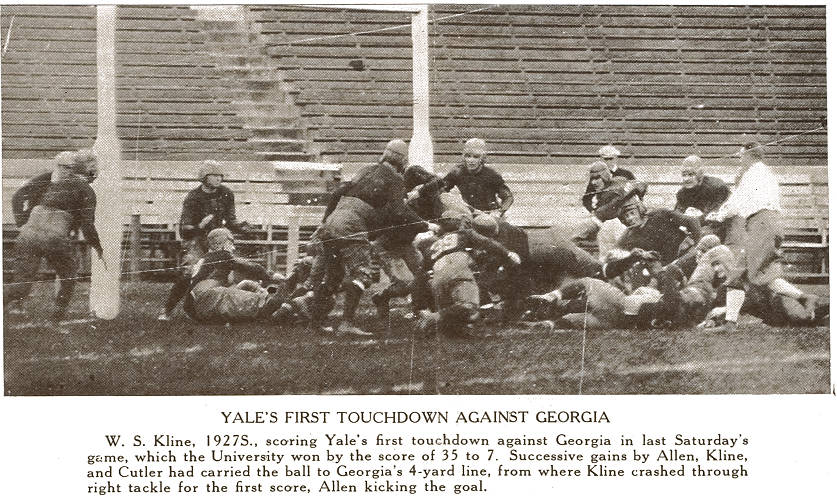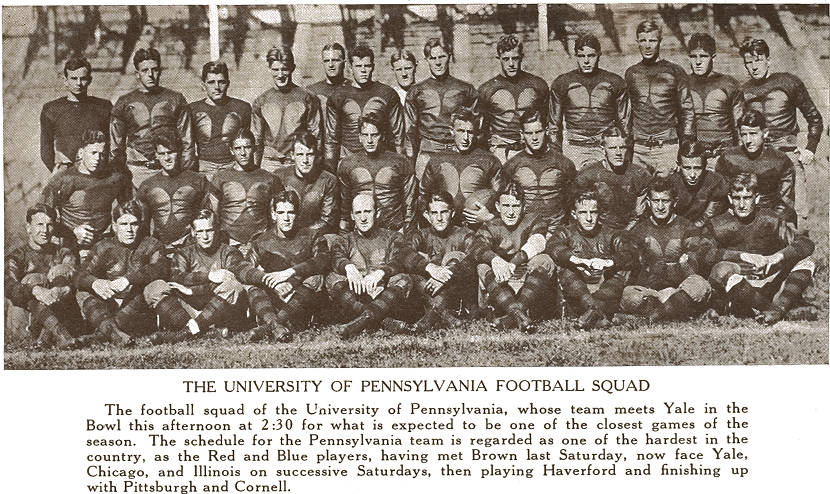Harvard
High Point: For a team with a winning record, I can't find any real high points. Three of the Crimson's four wins were over non-conference foes RPI, Middlebury and William & Mary. The fourth was a 3-0 win over Brown on Nov. 14, and even then Harvard was thoroughly outplayed if this article is to be believed. The big "victory" might be a scoreless tie with heavily-favored Yale in which the final whistle blew just as the Bulldogs lined up on Harvard's 3-yard line. (Remember, there were no digital scoreboards keeping time then, and only the officials knew the "real" time, kinda like soccer officials today.)
Low Point: Harvard was blown out by powerful Princeton and Dartmouth by a combined scored of 68-9.
 |
| Harvard opened the 1925 season against RPI; today, the schools play in the same hockey conference. Check out the RPI player with the letter "I" on the back! |
Uniforms: Like many other teams of the era, Harvard had moleskin patches stitched on some jerseys in order to help the ballcarriers better protect the ball.
Other Trivia: Head coach Bob Fisher was 43-14-5 over seven seasons at Harvard, highlighted by a win in the 1920 Rose Bowl. As a player, he was a two-time All-American for the Crimson.
Pennsylvania
High Points: There were 2:
1) On Oct. 17, Penn beat Yale 16-13 for the Quakers' first-ever victory over the Bulldogs after 12 losses. Fullback Al Kruez led a bruising ground attack, stopped Yale's running game on defense, and his field goal proved to be the difference on the scoreboard.
2) The Quakers capped a successful season with a 7-0 Thanksgiving Day win over archival Cornell at Franklin Field. Penn's touchdown came on a Charlie Rogers 42-yard scoop-and-score in the final quarter. The Philadelphia Inquirer, using enough purple prose to drown a printing press, referred to Rogers as "The Camden Comet" (he was from Camden, New Jersey) and "the doughy scion of Jersey." The article later said Rogers "galloped like some elusive spectre, some ghost of the gridiron." Which leads us to ...
Low Point: It might be unfair to call Penn's 24-2 Halloween loss to Illinois a "low point," since the main attraction wasn't so much the host Quakers as it was the Philly debut Red Grange, the Illini's "Galloping Ghost." Number 77 did not disappoint, running for 320 yards on 32 carries, including a 55-yard TD run on his first carry.
Oddly enough, the game drew "only" 60,000 fans to Franklin Field, 11,000 less than the Turkey Day turnout for Cornell. And probably 600,000 fans went on to tell their friends they were there when Red ran up, down and around the Quakers.
Uniforms: Even then, the Quakers had a recognizable look. Penn without the alternating red-and-blue stripes on the sleeves is like Ben Franklin without his bifocals. It's just not right. Going back to the 19th century, probably the only notable changes the Quakers had made to this point were the addition of helmets and numbers on the back. Notice the patches of the jersey fronts to help the ballcarriers. (I wonder if those actually worked?)
Other Trivia: Joseph Wilson, the captain, went on to serve 45 years as a United States district judge in Pennsylvania. ... Head coach Lou Young was 49-15-2 over seven seasons. It's interesting the note how successful coaches such as Young and Harvard's Fisher walked away from the game despite terrific records. My guess is that even then, coaching was a stressful profession.
Princeton
High Point: It's always good to beat those traditional rivals, right? Princeton topped Harvard and Yale by a combined score of 61-12. The 36-0 win over Harvard was Princeton's most dominant victory in the rivalry to date.
Low Point: A 9-0 loss to Colgate in driving rain on October 24 cost the Tigers an undefeated season. Eddie Tyron, who I wrote about in this post, scored the Raiders' lone touchdown and bottled the Tigers on their half of the field with his booming punts.
 |
| Princeton and Navy face off in 1925. As is often the case, good luck figuring out which team is which. |
Uniforms: Like Penn, Princeton's basic design dates back to the 19th century with those gorgeous tiger stripes. From what I've been able to gather, some jersey numbers were orange and some were white. But with those grainy 1920s photos, you can never quite tell.
Other Trivia: Center Ed McMillan was a consensus first-team All-American. Like many Ivy players, his post-playing career differed from his contemporaries, as he served as an examiner for the Pennsylvania Securities and Exchange Commission. ... Fullback Jacob Slagle was a non-consensus All-American at fullback. ... Coach Bill Roper remains the Tigers' all-time winningest coach; the William Winston Roper Trophy, the school's highest individual honor for a male athlete, is named in his honor.
Yale
High Point: I'm tempted to say a 35-7 win over Georgia on Oct. 10, but a) Georgia was 4-5 that year; b) Southern football was on the rise (see Alabama's co-championship that year), but it wasn't quite SOUTHERN FOOTBALL yet, with Sammy Baugh and Davey O'Brien and those guys. There was a 28-7 win over Army on Halloween, but the Cadets' 7-2 record was deceiving (among their victims: Detroit, Knox, Saint Louis, Davis & Elkins and Ursinus). I'll pencil in a 20-7 win over Brown over October 24, by default of nothing else. (Yale's other wins were over Middlebury and Maryland; the Terps were kinda in the same camp as Georgia.)
 |
| Good seats were still available at the Yale Bowl for the Bulldogs' 35-7 win over those other Bulldogs from Georgia. |
Low Point: If Harvard's scoreless tie with Yale was the high point of the Crimson's season, I'm guessing it was a low point of the Bulldogs' season. Another downer was the aforementioned 16-13 loss to Penn.
Uniforms: Basic stuff. I'm not sure if the helmets are blue as in the above graphic; I'm guessing that's lost to history.
Other Trivia: Guard Herbert Sturhahn was named to the first of two straight All-America teams. ... Tackle Johnny Joss, who was named to the New York Sun's All-America team, later coached college football in Mexico.
.png)

.png)



.png)
.png)